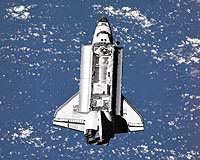Discovery’s astronauts prepare to move into new home
Astronauts used the international space station's robotic arm to examine a spot on the shuttle Discovery's left wing where sensors detected a "very low" impact, NASA officials said.

The shuttle crew traveled two days to reach the space station, where, during a weeklong stay, they will continue construction on the orbiting lab and replace German station crew member Thomas Reiter with another.
The sensor recorded a level of impact not considered worrisome, John Shannon, chairman of the mission management team said Monday, but managers decided to take a closer look to be safe and perhaps eliminate the need to do a time-consuming focused inspection later in this jam-packed mission. NASA officials have not determined the significance of the blip, though they do not expect it to affect the mission.
"It looks like something happened," Shannon said , noting that the wing looked fine during a focused inspection performed Sunday.
The shuttle delivered a 2-ton, $11 million (EUR 8.35 million) cube-shaped addition to the space station, using the shuttle and the station's robotic arms. The addition will be attached to the station during a spacewalk Tuesday.
To link up with the station, Discovery commander Mark Polansky moved the shuttle a tenth of a foot (3 centimeters) per second before latches connected it shortly before a sunrise.
"Space shuttle Discovery arriving," space station resident Michael Lopez-Alegria told Mission Control in Houston at 6:54 p.m. EST (23:54 GMT) as the hatch between the two spacecraft opened to the traditional ringing of a bell.
Televised images from the orbiting space lab showed Bob Curbeam, due to perform three spacewalks, bouncing over two hugging astronauts to shake the hand of space station resident Reiter, who will return to Earth with the shuttle crew. Christer Fuglesang, now the first Swede in space, spoke into a videocamera, then let it float away.
Eventually the two crews gathered for a group shot, all smiles and with some ponytails floating, as they flew 220 miles (350 kilometers) above Australia.
"You guys all look great," Mission Control radioed up. "We're waving back."
Six of Discovery's seven astronauts planned to spend a week at the space station. The seventh astronaut, Sunita "Suni" Williams, will live there for six months, replacing German astronaut Reiter of the European Space Agency.
The two will swap places before the end of the day, making Williams only the third woman in history to reside long-term at the space station.
About an hour before docking, Discovery did a slow back flip so the space station crew could photograph its belly for any signs of liftoff damage.
Polansky executed the maneuver as the shuttle flew about 600 feet (180 meters) beneath the station.
The space agency has been especially alert to damage to the shuttle's heat shield since the Columbia tragedy in 2003. A piece of foam broke off Columbia's external fuel tank during liftoff and gashed a wing, allowing hot gases to penetrate the spacecraft during its return to Earth. All seven astronauts died.
NASA on said Sunday that the shuttle's heat shield appeared to be in good shape, but that it will be a few days before engineers can rule out any damage from Saturday's liftoff, the first nighttime shuttle launch in four years.
Shannon said at a news conference late Monday that photos taken of the shuttle's underside before docking show white specks on the black tiles, suggesting the tiles were dinged.
"They just want to make sure the chips aren't deep," NASA spokeswoman Brandi Dean later said. Imagery teams are examining the photos and will decide whether a closer look is warranted, the AP says.
Shannon also said that managers would examine images showing an orange cellophane-like material used to keep nitrogen in place that is sticking out of the shuttle's left external fuel tank door. The material sometimes burns off by the time shuttles land, Shannon said, but engineers want to make sure it is not blocking the tank door's seal.
The station's new component will be put into place on Tuesday during the first of the mission's three spacewalks. Astronauts also plan to rewire the space lab, switching it from a temporary source to a permanent one, during the two other spacewalks.
Subscribe to Pravda.Ru Telegram channel, Facebook, RSS!

